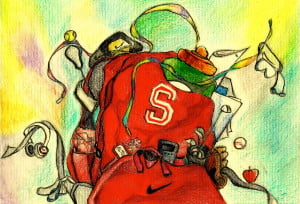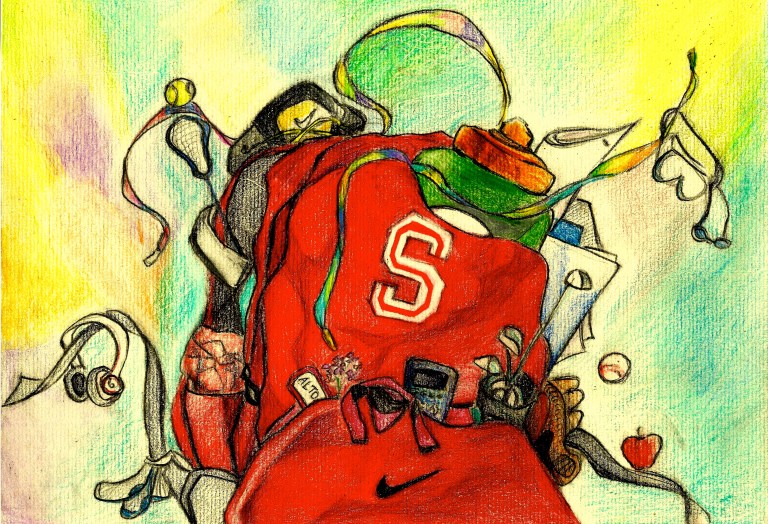“Tired. Pride — in your school and in yourself. Discipline — in time, in your sport, in going to bed.” That’s how Tate Murray, a senior on the track and field team, described her experience as a Stanford student-athlete.
“It’s hard to put into words something that you’ve worked your entire life for, that has always been a dream, and to finally actually be here and be one of the people on TV that you’ve always looked up to, but now you’re the one wearing the jersey with ‘Stanford’ across your chest,” said former women’s basketball player Toni Kokenis. “What that means is so much bigger than ourselves, which is just a really powerful feeling.”
All student-athletes have their own stories to tell, their own adversities they’ve overcome, their own sets of sacrifices and their own unique experiences that have made all of the hard work worthwhile.
Most student-athletes have never had an afternoon class. They’ve never been on dorm ski trips. They can’t make plans with friends because their schedules are out of their hands. They look forward to ice baths. They give up the four or five years of their collegiate experience to Stanford athletics while they are still expected to meet the expectations of Stanford academics. Waking up early is second nature — almost. Voluntary practices are actually mandatory. Many have to sacrifice studying abroad or make special arrangements to do so. A suitcase, hotel and the team bus become home during the season, but don’t be fooled into thinking that the offseason is any easier.
“A student-athlete has to eat three meals a day minimum,” said sophomore track athlete Steven Solomon. “They can’t miss a meal because that will affect them athletically. It’s not uncommon for me to be up at six in the morning, go to a training session, go to breakfast, go to three hours of classes in the morning and come back to my room and my roommate is still sleeping.”

The amount of time and commitment it takes to be a full-time student and a full-time athlete, especially at a top-tier school academically and athletically like Stanford, cannot be underestimated. There is a lot more to the students with the red backpacks than what one might assume.
It’s not just practice time and classes that consume an athlete’s day, either. Time spent in the front and back ends of practice adds up, and pulling an all-nighter is not necessarily an option when you have a 5:30 a.m. lift the next morning.
“You don’t realize how much time it takes up,” Murray said. “You don’t just have practice but [also] all the things that go with that: doctor’s appointments, going to the training room, the travel, stuff like that.”
A three-hour practice can turn into a five-hour ordeal, and some athletes even add on extra time to practice individually. Various women’s basketball players can be found in the Arrillaga practice gym directly after a game perfecting their shot and improving on that night’s performance.
But then there is the other side to being a student-athlete.
Nike Christmas. The Athletic Academic Resource Center. Pre-selected books waiting in labeled bags at the bookstore. Traveling around the country — and sometimes outside of it. Scholarships. Receiving a golf cart and massages when injured. Networking. Winning the Directors’ Cup 19 years in a row. Referring to non-student-athletes as “NARPs” (non-athlete regular people) or “regulars”. Representing a successful program.
None of it comes without a price. Stanford student-athletes do not get priority for choosing classes and don’t have the special dorms that other schools offer. Yes, there are perks, but those perks are rewards for a lot of hard work.
Overwhelmingly, the majority of student-athletes agreed that the greatest benefit of being a part of the Stanford athlete community is the camaraderie, the ability to relate to each other and the mutual respect that athletes develop and have towards each other.
“I just really love the guys on our team,” said senior Austin Hack, a member of the men’s rowing team. “It’s hard to compare it to a non-student-athlete life because you don’t spend a lot of time suffering together.”
It’s easy for athletes to fall into that sense of exclusivity or the “athlete bubble” because of their common goals and struggles in trying to achieve success both on the field and in the classroom.
“The reason that our training partners become such protagonist figures in our lives is because we literally and figuratively live and die by each other,” Solomon said. “That really sparks a kinship between two people that is really special and isn’t found in any other kind of friendships.”
“There’s no other way that you could conceive to build such a strong bond than by working and toiling together,” said junior rower Kaess Smit. “If people ask me, ‘Do you enjoy rowing?’, the actual process of rowing and training is always miserable but it’s the fact that you’re doing it with your boys [that makes it enjoyable].”
However, there are added pressures that come with the sport when student-athletes have to live up to Stanford’s legacy of athletic dominance. It’s easy to buy into the glory when they are walking advertisements for Nike and are a part of a successful program.
The pressure to uphold the University’s high standards in the classroom and the training room is intense. All of these pressures can warp the athletes’ priorities.
“It’s humbling to be surrounded by all these athletes and the legacy of Stanford athletics while not appreciating each individual athlete at the same time — you are a part of the Stanford Athletics brand,” one former Stanford athlete said to The Daily. “It’s too much about giving things up for the team and the program instead of doing anything for yourself.
“Somewhere along the lines, you buy into the identity without knowing it and that’s really dangerous because the more you buy into the identity, the more it controls you,” the athlete added. “A lot of the athletes buy into the glory, and that changes people.”
Dealing with the politics involved in athlete-coach relations and vying for playing time can be stressful as well. Sometimes seniority is favored and sometimes ability is the deciding factor, but ultimately, the player only has so much influence and say, even despite efforts by coaches to make decisions seem objective and not arbitrary.
In order to cope with it all, athletes are forced to quickly develop their time management skills and discipline. Some even admitted that they get more schoolwork done than they would’ve without playing a sport because procrastination is not an option with such a rigid schedule and any minute not used productively feels like a waste.
“I think that I am actually doing better [in school] than I would [otherwise] just being on the team,” said freshman volleyball player Clay Jones. “That foundation and fortitude kind of pushes me through my school work and it teaches me time management and I think it’s more beneficial than worse for me in my academic life.”
Despite athletes attending graduate schools in engineering, medicine and nursing, for example, and working for venture capitalists and the like during summer or the offseason, the stereotype persists that all athletes only got into Stanford because of their sport, can’t keep up with the course load or that they use their sport as an excuse for taking easy classes.
“Everyone had a unique path to get here,” said junior soccer player Haley Rosen. “Maybe I didn’t come in with the highest GPA or SAT, but I’m sitting in the classroom, learning like anybody else in class, and we’re all equally capable or else we wouldn’t be here.”
“It’s also frustrating how students will think that student-athletes never would’ve gotten in here without their sport,” admitted another athlete. “[That] is probably true, but what they don’t understand is that all the hours that [athletes] put in high school into extracurriculars and having time to study and take extra classes. We put all of that extra time and effort into going to soccer practice every night, missing school for tournaments, being gone every weekend. [We] got in with our own hard work in just a slightly different way.”
And athletes, of course, must take the same required classes and unit loads as their peers in order to earn a Stanford degree. In all, the typical Stanford athlete does not feel that he or she is so different from the type and quality of student that it takes to succeed at Stanford.
“I’ve learned by now that in certain classes, I don’t want to appear as an athlete,” one Cardinal student-athlete said. “They look at you and sometimes there’s a sense of, ‘You’re an athlete, maybe you’re not as intelligent.’ I try my hardest to disprove that, and it’s pretty infuriating.”
Non-athletes may spend the same amount of time on something as an athlete spends on his or her sport. However, athletes explain that there is a difference between the level of taxation and the rigidity of their schedules and those of other students.
Most students’ experiences at Stanford are defined by some job, activity, volunteerism or other driving force — something more than just attending classes. A sport is the job, club, organization, extra units, research and social scene of a non-athlete wrapped up into one all-consuming commitment — a commitment that most student-athletes both love and hate at the same time.
Senior basketball player Chiney Ogwumike summed up the experience for all when she said, “It’s challenging, yet rewarding.”
Contact Ashley Westhem at awesthem ‘at’ stanford.edu.
